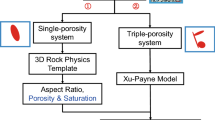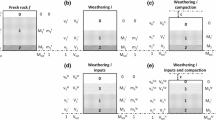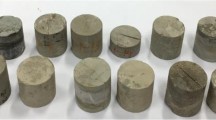Abstract
Based on the results of a study of the porous carbonate rocks in the Jinping area conducted from 2004 to 2019, we developed a research algorithm to analyze polarized images of these rocks and compared the porosity magnification of these polarized images. We obtained the current karst development rate by combining the historical karst development rate with the porosity magnification. To verify the accuracy of the image analysis results, we used the traditional carbonate rock research method (TCRM) to conduct a laboratory simulation experiment on carbonate rocks.If the difference between the two sets of results was within \(\pm 5\%\), the two were considered to be consistent. Based on the image analysis results and laboratory simulation experiments, the karst development rate was verified, and the causes of the changes in the porosity were investigated. According to the experimental results, the pore sizes of the carbonate rocks collected from the same area during different periods changed significantly. We found that the karst development rate of the carbonate rock formations in the Jinping area has accelerated.





Similar content being viewed by others
References
Amankwah A, Aldrich C (2010) Rock image segmentation using watershed with shape markers, 2010 IEEE 39th Applied Imagery Pattern Recognition Workshop (AIPR) https://doi.org/10.1109/AIPR.2010.5759719
Baechle G, Weger R, Eberli G, et al (2004) The role of macroporosity and microporosity in constraining uncertainties and in relating velocity to permeability in carbonate rocks, SEG, 2586
Chen G, Yang J, Liu Y (2013) Rock pore recognition method combining fuzzy c-means clustering and bp neural network. Comput Knowl Technol 30:6872–6873
Coskun S, Wardlaw N (1995) Influences of pore geometry, porosity and permeability on initial water saturation - An empirical method for estimating initial water saturation by image analysis. J Petrol Sci Eng 12(4):295–308
Gao G (2013) Method for predicting the porosity based on the pore structure of carbonate. Prog Geophys 28(2):920–927
Gao G, He Z, Huang D et al (2013) Research on predicting the porosity of carbonate reservoir in the northeast area of Sichuan. Sci Technol Eng 10:23–29
Heidari M, Khanlari G, Torabi-Kaveh M et al (2013) Effect of porosity on rock brittleness. Rock Mech Rock Eng 47(2):785–790
Hellmuth K, Siitari KM, Klobes P et al (1999) Imaging and analyzing rock porosity by autoradiography and Hg-porosimetry/X-ray computer tomography-applications. Phys Chem Earth, A Solid Earth Geodesy 24:569–573
Hosseinzadeh A, Sardar H (2010) Computation of porosity using sand and carbonate rock physics models in an Iranian oilfield. ASEG Extended Abstract 2010(1):1–3
Kuang H (2002) Karst Information System in Jinping Area, Master Dissertation of Southwest University
Kuang H (2008) The simulation experiment of deep karst and hydrology: a case study in the research of the carbonate rocks stratums of Jinping, Doctoral Dissertation of Southwest University
Kuang H (2012) Pattern recognition of carbonate rocks in RS image. Key Eng Mater 500:37–39
Kurz T, Dewit J, Buckley S et al (2011) Hyperspectral image analysis of different carbonate lithologies (limestone, karst and hydrothermal dolomites): the pozalagua quarry case study (Cantabria, North-west Spain). Sedimentology 59(2):623–645
Li J, Hussaini S, Dvorkin J (2020) Permeability-porosity relations from single image of natural rock: subsampling approach. J Petrol Sci Eng 194:107541
Li J, Wang D, Kang T (2010) Alogorithmic study on rock pore structure based on micro-ct experiment. Chin J Geotech Eng 11:67–72
Liu J (2008) Image segmentation algorithm based on grey model MRF. J Comput Appl 28(3):686–687
Liu Y, He S, He Z et al (2019) Carbonate overpressure rock physical simulation experiment and overpressure prediction theoretical model. Oil Gas Geol 4:716–724
Milner M, McLin R, Petriello J (2010) Imaging texture and porosity in mudstones and shales: Comparison of secondary and ion-milled backscatter SEM methods, Canadian unconventional resources and international petroleum conference, https://doi.org/10.2118/138975-MS
Mai S, Elakneswaran Y, Toyoharu N et al (2019) Influence of carbonated water-rock interactions on enhanced oil recovery in carbonate reservoirs: experimental investigation and geochemical modeling. J Japan Petrol Inst 62(1):19–27
Mowers T, Budd D (1996) Quantification of porosity and permeability reduction due to calcite cementation using computer-assisted petrographic image analysis techniques. AAPG Bull 80(3):309–321
Nabawy B (2014) Estimating porosity and permeability using digital image analysis (DIA) technique for highly porous sandstones. Arab J Geosci 7(3):889–898
Neto I, Misságia R, Ceia M et al (2014) Carbonate pore system evaluation using the velocity-porosity-pressure relationship. J Appl Geophys 110:23–33
Parra J, Hackert C (2006) Modeling and interpretation of Q logs in carbonate rock using a double porosity model and well logs. J Appl Geophys 58(3):253–262
Parra J, Hackert C, Bennett M et al (2003) Permeability and porosity images based on NMR, sonic, and seismic reflectivity: application to a carbonate aquifer, application to a carbonate aquifer. The Leading Edge 22:1102–1108
Pascual A, Shu L, Szoke-Sieswerda J, et al (2019) Towards natural scene rock image classification with convolutional neural networks, 2019 IEEE Canadian Conference of electrical and computer engineering
Peng R, Yang Y, Ju Y et al (2011) Computation of fractal dimension of rock pores based on gray ct images. Chin Sci Bull 56(31):3346–3357
Pret D, Sammartino S, Beaufort D et al (2010) A new method for quantitative petrography based on image processing of chemical element maps: Part II. Semi-quantitative porosity maps superimposed on mineral maps. Am Mineral 95(10):1389–1398
Purswani P et al (2020) Evaluation of image segmentation techniques for image-based rock property estimation. J Petrol Sci Eng 195:107890
Purswani P, Tawfik M, Karpyn Z et al (2019) On the development of a relative permeability equation of state. Comput Geosci 10:1–19
Rajabzadeh M, Moosavinasab Z, Rakhshandehroo G (2011) Effects of rock classes and porosity on the relation between uniaxial compressive strength and some rock properties for carbonate rocks. Rock Mech Rock Eng 45(1):113–122
Robert J, Dietterich W, Full E (1986) Pore analysis of mississippian carbonate reservoir in southwest kansas using petrographic image analysis:abstract, AAPG Bull, 70
Robson B, Bolch T, Macdonell S et al (2020) Automated detection of rock glaciers using deep learning and object-based image analysis. Remote Sensing Environ 250:112033
Rötting T, Luquot L, Carrera J et al (2015) Permeability, water retention curve and reactive surface area during carbonate rock dissolution. Chem Geol 403:86–98
Sammartino S, Siitari-Kauppi M, Meunier A, Sardini P, Bouchet A, Tevissen E (2019) An imaging method for the porosity of sedimentary rocks: adjustment of the PMMA method-example of a characterization of a calcareous shale. J Sedimentary Res 72(6):937–943
Shao W, Xie J, Chi X et al (2013) On the relation of porosity and permeability in low porosity and low permeability rock. Well Logging Technol 37(2):149–153
Soleimani P, Shadizadeh S, Kharrat R (2020) Experimental investigation of smart carbonated water injection method in carbonates. Greenhouse Gases Sci Technol 10:208–229
Song Z, Zhou Q, Xiao A et al (2014) Study on porosity of low-permeability rocks collected from F4 fault zone in Gansu Beishan region based on digital image analysis. World Nuclear Geosci 31(suppl):1
Wang J, Gao J, Liu L (2009) Porosity characteristics of sandstone by x-ray ct scanning system. Acta peterolei sinica 6(887–893):897
Wang Z, Xu S, Zhang T et al (2009) Application of image segmentation in rock pore structure analysis. Comput Appl Petrol 04:19–21
Xie S, He Z, Qian Y et al (2015) Multifractality of 3d pore structures of carbonate rocks based on ct image. J Geol 39(1):46–53
Zhang S, Chen Y, Hong J et al (2006) Three dimensional visualization for ct tomographic image of microscopic flow law of rock pore. J Oil Gas Technol 9:120–124
Acknowledgements
We thank Accdon (www.accdon.com) for its linguistic assistance during the preparation of this manuscript.
Author information
Authors and Affiliations
Corresponding author
Additional information
Publisher's Note
Springer Nature remains neutral with regard to jurisdictional claims in published maps and institutional affiliations.
Rights and permissions
Springer Nature or its licensor holds exclusive rights to this article under a publishing agreement with the author(s) or other rightsholder(s); author self-archiving of the accepted manuscript version of this article is solely governed by the terms of such publishing agreement and applicable law.
About this article
Cite this article
Kuang, H., Wang, P., Ai, X. et al. Study of the karst development rate of the Jinping porous carbonate rock formation based on porosity analysis of rock images. Carbonates Evaporites 37, 55 (2022). https://doi.org/10.1007/s13146-022-00801-5
Accepted:
Published:
DOI: https://doi.org/10.1007/s13146-022-00801-5




